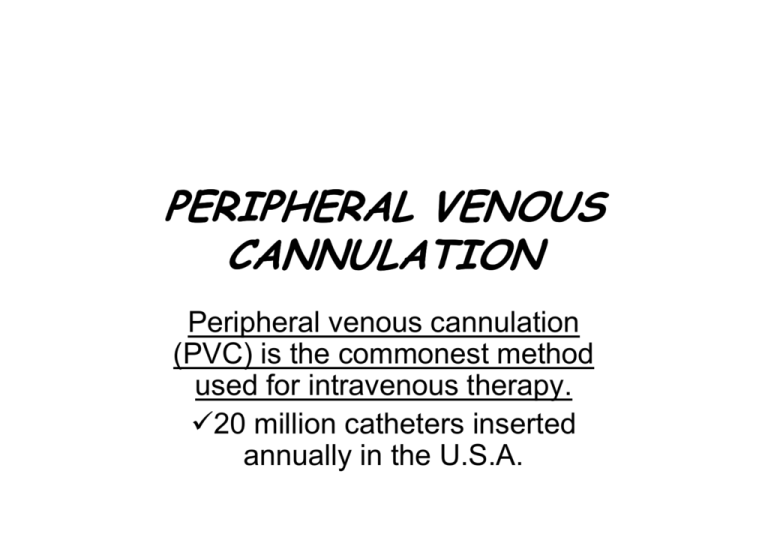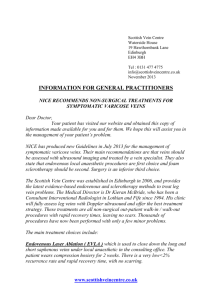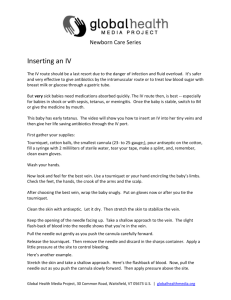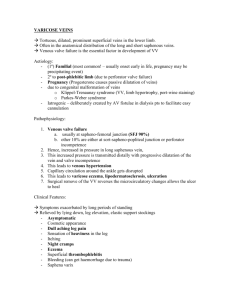Peripheral venous cannulation
advertisement

PERIPHERAL VENOUS CANNULATION Peripheral venous cannulation (PVC) is the commonest method used for intravenous therapy. 20 million catheters inserted annually in the U.S.A. Indications for peripheral venous cannulation Intravenous fluids. Limited parenteral nutrition. Blood and blood products. Drug administration (continuous or intermittent). Prophylactic use before procedures. Prophylactic use in unstable patients. Surgery Blood samples CPR Equipment 42ml/min. 236ml/min. 67ml/min. 270ml/min. 103ml/min. 133ml/min. Choice of cannula • The flow rate through a cannula is proportional to the height of the fluid reservoir and the fourth power of the cannula’s radius. Thus, doubling the cannula’s diameter increases the flow by 24. • For infusions of viscous fluids such as blood, and for rapid infusions, the largest cannulae should be used. • Smaller sizes should suffice for crystalloids. • The smallest cannulae are adequate for the intermittent administration of drugs, except those that must be given by rapid infusion. Cannula-venflon • angiocath needle= the stylet • the cannula • flashback chamber • luer plug Topical venodilatation • The tourniquet prevents venous return of blood, causing the vessel to dilate. • If a suitable vein is not identified after the application of a tourniquet, having the patient hold the extremity in a dependent fashion will also help to engorge the vessel. Topical venodilatation • A tourniquet should be applied 5–10 cm proximal to the selected site. The compression must permit arterial inflow while restricting venous outflow. • Sphygmomanometer cuff inflated to diastolic pressure can also be utilised. • Warming of the limb improves peripheral vasodilatation. This can be done with warmed poultices or a basin of water. Using a carbon fibre "warming mitt", which was designed to provide reproducible amounts of heat, • Topical venodilatation may also be achieved by applying 4% nitroglycerine ointment, smeared onto the skin and left for 2–3 minutes. Potenital IV Sites The vein is visible as a blue-green subcutaneous structure. Upper Extremity Intravenous catheters are inserted in • the antecubital fossa, • the forearm, • the wrist, or • the dorsum of the hand. Upper Extremity Cannulation of the cephalic, basilic, or other unnamed veins of the forearm is preferrable. The three main veins of the antecubital fossa (the cephalic, basilic, and median cubital) are frequently used. These veins are usually large, easy to find, and accomodating of larger IV catheters. Thus, they are ideal sites when large amounts of fluids must be administered. However, their location in a flexor region is a drawback, as bending of the elbow can be uncomfortable to the patient and may occlude the flow of the intravenous solution. Upper Extremity • The veins in the dorsal hand may be utilized if large bore access (18 gauge or larger) is not required. Care must be taken to find a vein that is straight and will accept the entire length of the catheter. • The portion of the cephalic vein in the region of the radial styloid is commonly known as the "student's" or "intern's" vein, as it is often a large, straight vein that is easy to cannulate. Lower Extremity • Cannulation of the veins of the feet is not ideal. Insertion can be quite painful, and the catheter may cause more discomfort than if it were started in the hand or forearm. Additionally, IV catheters placed in the feet are more likely to become infected, to not flow properly, and are more likely to produce phlebitis. • The great saphenous vein runs anteriorly to the medial malleolus. The lesser saphenous vein runs along the lateral aspect of the foot. These two veins converge medially to form the dorsal venous arch. There are numerous unnamed vessels that are branches of these veins. (Clemente) Any vein in the foot large enough to accept the IV catheter may be used if necessary. Neonates, infants, children • In neonates, vascular access can be obtained via the umbilical vein, although this has been associated with portal vein thrombosis. • In infants, scalp veins are often amenable to cannulation, and central catheters can also be inserted by this route. • Intraosseous infusions have also been used for fluid administration in haemodynamically compromised children, although care must be taken with needle placement in order to avoid injury to epiphyseal growth plates. General Concepts • Ease of access • Use of the non-dominant extremity • Avoiding joint areas • Avoiding use of the lower extremities Contraindications • Pre-existing Vascular Compromise Lymphatic or venous drainage has been compromised, i.e. lymph node dissection accompanying mastectomy, A-V fistulas, injured extremities, thrombosis. • Regional Infections - overlying cellulitis or infection Explain the Procedure • Explain the procedure to the patient. Tell the patient that the procedure may be mildy painful, but is brief. Ask that he / she hold the extemity completely still until the completion of the cannulation. Take time to answer any questions that the patient might have. Patient Positioning • As with any procedure, positioning of both the patient and the performer should be optimized. • The patient should be seated or in a reclining position for comfort and safety. • Immobilize the extremity, particularly for pediatric or uncooperative patients. Keep the extremity in full extension to make the vein taut, and place the intended cannulation site in a dependant position to engorge the vein. Mise-en-Place • In French, and in cooking, this means to lay out all of your expected ingredients and equipment ahead of time, prepared and within reach. • It is often beneficial to have a selection of IV catheters available as well as extra blood tubes, tape, etc., should additional supplies be required. Use of local anaesthetic • In paediatric practice, it is now commonplace to use topical anaesthesia prior to either venepuncture or cannulation, but this is not the case in adult medicine. Topical Anesthesia • While anesthesia is not routinely utilized for intravenous cannulation, its use should be considered in special situations. Topical anesthetics are often used for venepuncture on children, to reduce anxiety and pain. • EMLA (eutectic mixture of local anesthetics) cream contains 2.5% lidocaine and 2.5% prilocaine. It is applied as a thick dollop of cream to the area of venepuncture, and then covered with an occlusive dressing. • It must remain on the skin for 60 minutes prior to the procedure to achieve maximum tissue preparation. • EMLA is extemely safe to use, but it should not be left on for more than two hours. Cases of methemoglobinemia have been reported, however these are exceedingly rare and in most cases involved large doses of EMLA which were in contact with the skin for an extended period of time. Cannulation procedure • Wash hands and apply non-sterile gloves • Apply a tourniquet to the upper limb to improve venous filling. This should not obstruct arterial blood flow and the radial pulse should still be palpable. • Ask the patient to open and close the fist to promote venous filling. • Clean the skin with alcohol solution and allow to dry. • Do not re-palpate the skin. Cannulation procedure • Open the cannula carefully and ensure the stylet within the cannula is positioned with the bevel uppermost. • Hold the cannula in line with the vein at a 10-30˚ angle to the skin and insert the cannula through the skin. • As the cannula enters the vein blood will be seen in the flashback chamber. • Lower the cannula slightly to ensure it enters the lumen of the vein and does not puncture the posterior wall of the vessel. • Advance the device up to five millimetres into the vein. • Keep the stylet still or • Withdraw the stylet slightly. The stylet must not be reinserted as this can damage the cannula, resulting in catheter embolus. • At the same time slowly advance the cannula into the vein, ensuring the vein remains anchored throughout the procedure. Cannulation procedure • Release the tourniquet. • Dispose of the stylet in the sharps’ container at the bedside. • Flush the cannula to check patency and to ensure easy administration without pain, resistance or localised swelling. • Secure the cannula with a moisture-permeable transparent dressing (Opsite dressing ) • The dressing should allow viewing of the entry site while firmly stabilising the cannula to prevent mechanical phlebitis or cannula dislodgement. • . Predict The Difficult Access Conditions that may predict difficult access include: • Dehydration/intravascular depletion • Chronic illness with venous scarring from frequent IV access • IV drug use with venous scarring • Obesity • Significant edema • Tortuous, fragile vessels due to advanced age • Thin vessel walls due to age, steroid use, certain disease conditions Alternative Techniques may be required. Difficulties • It is often complicated in patients who are afraid of needles or have had bad experiences because fear activates the sympathetic nervous system thereby provoking peripheral vasoconstriction. Once an initial attempt has failed, nearly all patients experience a degree of sympathetic activation that makes subsequent attempts increasingly difficult ! The Difficult Vascular-Access Algorithm • The other most commonly overlooked peripheral veins for IV access are the deep brachial veins. These veins are paired structures, which lie medial and lateral to the brachial artery, and are most accessible 1-2 cm superior to the antecubital crease. Because these veins are neither palpable nor externally visible, they are often patent and untouched by IV drug users. deep brachial veins • Positioning • The patient’s arm should be placed in relaxed extension for easy accessibility to the antecubital fossa. • Technique • After applying a proximal tourniquet, landmark identification begins with the biceps tendon. More medially, the brachial artery should be palpable. The deep brachial vein lies both medial and lateral to the artery. Most practitioners cannulate the medial branch of the deep brachial vein, because the lateral branch lies directly posterior to the biceps tendon and is difficult to access (Figure 3). It is crucial not to use the standard 1.25-inch angiocatheter commonly used to cannulate most peripheral veins because of the vein depth. Instead, a longer 2-inch angiocatheter should be placed (Figure 4). This longer catheter should puncture the skin at the antecubital crease at a 45-degree downward angle. The Difficult Vascular-Access Algorithm • Airway, Breathing, and Circulation. There is significantly less attention paid to the “C” of circulation and the difficult vascular-access patient. What is the next appropriate step when it is unable to place a peripheral intravenous catheter? • One of the two most commonly overlooked peripheral veins is the external jugular (EJ) vein. Anatomically, the EJ begins at the mandibular angle and drains the posterior auricular and retromandibular veins. Coursing medially and superficially over the sternocleidomastoid (SCM) muscle, it pierces the fascia to join the subclavian vein under the clavicular head of the SCM muscle external jugular (EJ) vein Positioning • Patient positioning for the EJ line is crucial to the success of intravenous catheterization. Placing the patient in the Trendelenburg position increases venous distention and thus maximizes EJ visibility. Further, rotating the patient’s neck away from the side of the EJ gently stretches the vein and maintains slight tension to reduce the incidence of vein-rolling. Technique • Because the EJ is a peripheral vein, the same basic principle of inserting a peripheral IV catheter applies. Having the patient perform a Valsalva maneuver during the procedure enhances visualization of the EJ vein. Also, it is important to maintain a shallow angiocatheter angle at approximately 5-10 degrees when puncturing the skin and vein. The Difficult Vascular-Access Algorithm • Central venous catheterization should be the next step when peripheral IV access is unsuccessful or when more central access is required. Ultrasound guided venepuncture • is an established technique for both peripherally inserted central catheters and central venous cannulation. • it has been suggested that, with the increasing availability of portable ultrasound facilities, this may become an option in the future for difficult peripheral venous cannulations. • a hand held Doppler probe has been used to identify accurately forearm veins of more than 2 mm diameter in patients with invisible and impalpable veins. Early Complications • Infiltration and Extravasation Infiltration of the IV occurs when the tip becomes dislodged from the vessel lumen. This complication should be suspected when the intravenous fluid flows poorly, if the line is difficult to flush, if the automated pump sounds an alarm, or if the patient complains of pain. Infiltration can become a serious situation if toxic fluids are being administered through the line. These include hypertonic agents, cytotoxic agents, and vasopressors. Vasopressors, such as norepinephrine or dopamine extravasate into local tissues from an infiltrative line, severe tissue necrosis may result. Early Complications • Arterial Placement Peripheral catheters may accidentally be inserted into arteries instead of veins. This would occur most commonly in the antecubital fossa, with the catheter entering the brachial artery instead of the median cubital or basilic vein. Arterial cannulation is distinguished by arterial flow (pumping) of blood, which will also be a bright scarlet red if patient is not hypoxic. In this situation phlebotomy may still be performed but the catheter should subsequently be removed. Pressure should be placed over the site for one full minute, longer if patient is coagulopathic. Early Complications • Air embolism Air embolism is more commonly seen with central venous catheters, however may also occur with peripheral catheters. If air is introduced into the vascular system, it may accumulate and cause complications such as blockage of the right side of the vascular system (i.e. venous) leading to outflow obstruction of the right ventricle and pulmonary arteries. Possible symtpoms include impaired gas exchange, hypotension, and circulatory collapse. Left-sided (arterial) obstruction may also occur, if an atrial or ventricular septal defect is present. Obstruction of the coronary or cerebral arteries by air can lead to myocardial infarction and acute stroke, respectively. Early Complications • Air embolism While it is classically taught that 5 ml / kg of air is needed to produce an "air lock" of the right ventricle and pulmonary artery, circulatory collapse has been reported with as little as 20cc of air. To prevent air embolism, all tubing should be flushed prior to utilization. Additionally, all connections must be tight, and fluid bags should not be allowed to completely empty before replacement. Early Complications • Catheter fracture and embolism Catheter embolism is a rare complication of peripheral intravenous catheters. If the tip of the synthetic catheter is sheared off, it may potentially embolize and travel proximally in the circulation. This sequence of events occurs when the needle is withdrawn from the catheter and then reinserted. Therefore, once the needle is removed it should never be reinserted. Catheter embolism carries a high complication rate (up to 49%), and fluoroscopic catheterization and retrieval of the foreign body is usually recommended. Late Complications • Infection Infection is a common complication of intravenous therapy. Intravenous catheters can lead to local infection as well as bacteremia from several mechanisms. The most common source of infection is skin flora, which migrates distally down the intravenous catheter. Coagulase negative staph and staphylococcus aureus, as well as yeasts (e.g. candida), are frequent isolates responsible for infection. Other sources of infection include hematogenous spread from distant infections, as well as infected solutions or other equipment. The diagnosis of infection related to peripheral venous catheters is relatively straightforward. In most cases, localized inflammation, induration, and erythema will be present. Late Complications • Thrombophlebitis Peripheral venous thrombophlebitis, an extremely common complication, is heralded by pain, erythema, swelling, and a palpable cord along the course of the cannulated vein. Thrombophlebitis is caused by local damage to the venous wall, and resultant inflammation and thrombus formation. Late Complications • Thrombophlebitis There are multiple risk factors for the development of thrombophlebitis. The length of duration of cannulation is proportional to the risk of thrombophlebitis. Catheters placed in the veins that overlay joints are more likely to cause thrombophlebitis, as motion of the joint can cause frictional trauma between the endothelium and the catheter. Stagnant blood flow in the lower extremities makes veins in this location more likely to develop thrombophlebitis. Numerous intravenous fluid solutions, such as potassium chloride, barbiturates, phenytoin, and chemotherapeutic agents, are known to cause endothelial damage and inflammation. Finally, poor technique and multiple attempts lead to vascular damage and thrombophlebitis. Late Complications • Thrombophlebitis Should thrombophlebitis developed, the intravenous catheter should be removed immediately. The most circumstances, no treatment is needed other than elevation of the extremity and the application of warm compresses. Antibiotics may be required if there is evidence of surrounding infection. Complications • OCCLUSION Cannulae may become occluded when infusion containers ‘run dry’ or flush solutions are not administered appropriately. Cannula’s must never be forcibly flushed. To prevent infection and complications. • Handle with care: don't contaminate the equipment • Inspect the site: the insertion site should be checked regularly for any signs of infection or complications • Change the dressing: if a dressing is wet or soiled, get it changed • Securing the cannula: the cannula should be fixed securely, preferably clear tape/dressing where you can see the cannula itself. • Change the cannula: A new cannula is usually inserted every two to three days. Don't leave a cannula in, the longer you leave it the more risk of complications. • Flush: A cannula needs to be flushed regularly, before and after any medication is given into them. • Avoiding lower extremity insertion sites







